All parents strive for their children to be smart, develop quickly and be interested in learning. But it is not always so easy and simple to interest the little one in the process of learning something new.
The earliest interest in knowledge in children is precisely the counting of objects. It is important not to miss this time and quietly turn arithmetic into an exciting, fun game.
At what age should parents start?
Many people have a natural question: “Is it worth loading a child with arithmetic before school? After all, professionals will teach everything there”.
It's deep misconception. You need to start teaching the baby when he begins to be interested in the subject of training, and not after his interest has long faded away.
And the interest in counting in children appears quite early, from about 3.5-4 years. Only it needs to be slightly supported and imperceptibly complicate the gameplay every day.
If for some reason your cub does not show interest in counting toys, you don’t need to say: “He probably just doesn’t have the ability to do arithmetic, so I didn’t excel in the exact sciences as a child either.” You need to interest him. Gradually include in his daily developmental activities what you have missed so far: start counting toys, buttons on clothes, steps on the way home.
How to teach a child to count in the mind and avoid mistakes?
There are many different methods for teaching counting, you are free to choose or mix them and come up with your own. However, you should not start learning to count in such ways that not only will not bring any benefit, but will also harm your child in the future.
For example, "adding units": “In order to add two to three, we first add one to three, we get four, then to four one, we get five”. And in reverse side: “In order to subtract three from four, we subtract one from four, there will be three, then one from three, we get two and also one from two, there will be one”.
This method is very common, but it develops and reinforces in children the habit of slowly counting and does not develop memorization and thinking at all. Make sure that kindergarten teachers or primary school did not use the technique of fingers and ones to teach the child. It is quick and easy to learn, but it is very difficult to break this habit.
Another common wrong way - "by ruler": “To add two to three, you need to find the number three on the ruler, count two points to the right from it and read the five, this will be the answer to the example. And in order to subtract three from four, we find four on the ruler, count three points to the left from it and read the answer on the ruler ". This type of account using a kind of improvised “calculator”, like a ruler, as if specially invented so that the baby does not start to think and remember.
How to teach a child to quickly count in his mind?
The study oral account should always take place with elements of the game. With the help of training sessions, which are necessarily repeated daily, not just thoughtless memorization is achieved, but conscious memorization of both visual and tactile memory, which is then fixed for a long time.
It is important to maintain the algorithm and consistency of the acquired skills:
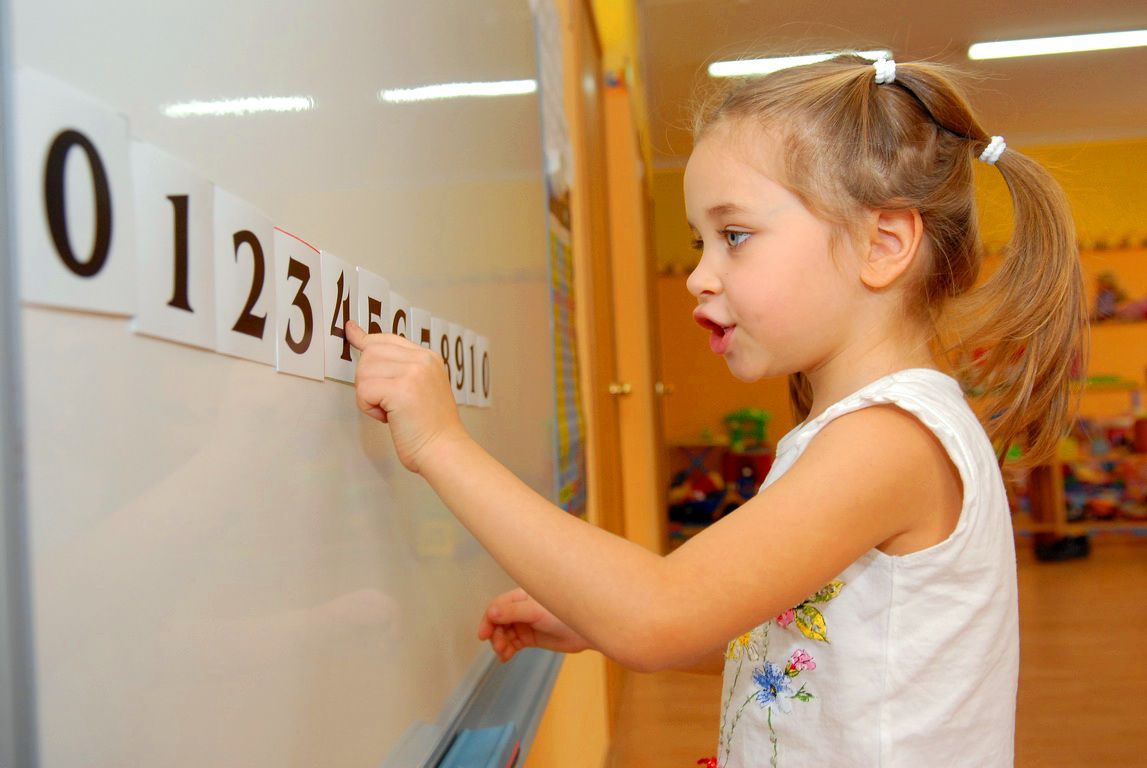
- Learn to see the difference between "many items" and one" ;
- Explain the difference between the concepts: “equal”, “greater than”, “less than”;
- Teach ordinal counting and quantitative;
- Explain how to match the quantity with the accompanying figure;
- Learn the components from 1 to 10;
- Learn how to find the answer in elementary math problems in several ways.
Only counting in the mind will develop memory, intelligence and ingenuity. This is what will come in handy in future adult life.
Your child will still solve examples at school, while practicing accuracy and attention. And the account in the mind needs to be worked out in early age to develop intelligence. By the beginning of mastering the oral count, he should already be able to correctly count at least five toys, buttons, birds, or fish, and at the same time understand the concepts of "more" and "less". All these improvised items in further training do not need to be used.
It’s worth starting with the addition and subtraction of homogeneous objects. This involves both visual and tactile memory. If a child has problems counting objects, it is better to start from the very basics and patiently explain to him again how to cope with determining the number of buttons on a shirt, for example. And then move on to more difficult lessons.
How to teach a child to count in the mind on cubes
There is a wonderful and fast way learning with cubes. You can start doing this from the age of two. It will take for this only cards from 1 to 5 and a box with squares in a row. You can buy them at any children's store or make your own. By the way, the little one will be happy to take part in this.
Do not replace the box with counting sticks or cubes that cannot be lined up. Such objects stand randomly, they do not have a permanent configuration, so they cannot be deposited in memory as a whole picture. in them and fundamental difference from fingers. The box can be covered with the palm of your hand or removed from your eyes, filled and empty cells will quickly be remembered. And his fingers are always with him, he can easily feel them, and there is simply no point in remembering anything.
Game-training "Put the cubes to the numbers"
Leave a card at number 1 and at number 2 on the table. Next to it is a box in which there is one cube.

Ask your child how many filled cells are in the box. After he answers correctly, show him the card with the number 1, name it and leave it next to the box. Put another one in the box and ask them to say, not counting how many cubes are now.
After you get the correct answer, that now there are already two objects in the box, put the number 2 next to it, name it, remove it from the box number 1, and put the number 2 in its original place. Repeat this game several times.
The student will quickly memorize the appearance of two cubes, and will soon begin to determine the number immediately, without counting. At the same time, it will remember the cards with the numbers 1 and 2 and will show the number corresponding to the number of cubes in the box.
Game-training "Gnomes in the house"
A box with cubes will be a house, cages will be rooms, and the objects themselves will be fabulous gnomes. Put the cube in the box. This will - "One gnome went into the house". Then ask: “And what if one friend comes to the first one, how many gnomes will be in the house?” If the baby cannot speak right away, put another cube near the house. Now he will definitely say that there are two gnomes in the house.
Same with the question: "If one gnome leaves". Gradually make the game harder. Say that now the house has a roof. Close the box with something and repeat the process. Each time a student says the correct number of gnomes, remove the roof and let him add or remove a gnome and make sure he answers correctly.
Remember for yourself that children do not need to upload all the information at once. It is not worth overloading a child's memory, forcing him to do it by force. Enough 15-20 minutes a day, unless of course he himself asks for more time.
You can combine counting lessons with reading lessons. Over time, when the simplest examples are worked out to automatism, teach you to see arithmetic in the world around you. For example, a great way to teach a child to quickly count examples in his mind is to count the components of the numbers of cars coming by.
It is interesting for children to keep track of the car and have time to count the numbers on the number and this is a great workout. Stock up on patience, imagination and remember that your child is always the smartest for you!
When the baby grows out of diapers, begins to run, talk and be interested in everything, loving parents think about how to teach a child to count. These skills are very helpful. little man and the sooner he masters them, the better.
Next, let's talk about how to introduce the baby to numbers and numbers up to 100.
When should you teach your child to count?
No one can name the exact dates, but it has been scientifically proven that at the age of 2-3, a child has the strongest need for new knowledge and information. Now the baby is ready to learn everything, he absorbs knowledge like a sponge, reaches for the unknown and in general is an ideal soil for cultivating certain abilities.
That is why it is better to start introducing the baby to numbers in the period from two to three years. However, you can do it earlier. Already at the age of one, children are able to understand that one and two are different things, although they are not yet able to fully comprehend the quantitative states of objects.
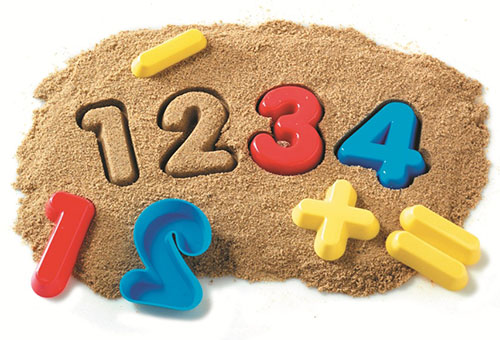
How to teach to count to 10?
Counting to 10 is the main task that a parent of a small child needs to set. But it can be difficult for a baby to master 10 numbers at once, so teach your baby to count to 5 first.
To do this, you can resort to the following methods, which are easy to implement at home.
- There are five fingers on the hand - starting from this, introduce the little one to the "names" of the numbers.
- Show cards with objects depicted on them (from one to five) - remember, it is better not to show the image of the numbers themselves to the baby.
- Educational cartoons and programs - they can be found on the Internet.
- Abacus and other educational toys.
- Rhymes and jokes.
- Account in Everyday life.
It is very good if you introduce the baby to household chores, while teaching the account at the same time. For example, you can have your baby wash five cups. At the same time, ask the child to count: one cup, two cups. Or, before going to the store, ask your child to memorize five items from the grocery list. The child should remind you of what to buy. At the same time, you can bend your fingers so as not to lose count. This will both teach the child to count in the mind and take care of the development of his memory.
Card lessons will be helpful. Such manuals are sold in all bookstores and online stores for children. First, show the cards in sequence, then alternate - let the child answer how many objects are shown on the card (remember that we do not teach how to write numbers yet!)
But try not to bother the baby with your "math". Do everything unobtrusively and easily, in game form so that the baby does not feel like a student in a school class ahead of time.
This activity is similar to when you want to teach a child to read by syllables and gradually introduce him to letters and sounds. Take your time, make sure that the baby has learned the information well before moving on to the next stage of learning.
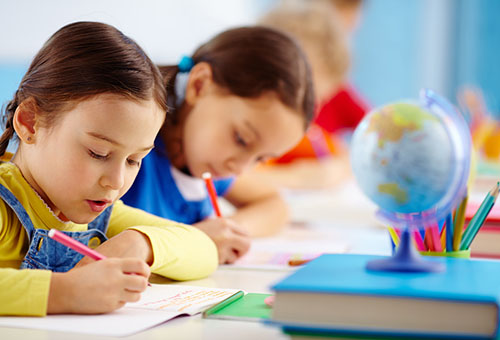
How to teach a child to write numbers?
After the first 10 digits have been learned, you can show your child how they are written. It is better not to burden the baby's memory and study one written number a day.
Dedicate the whole day to the number:
- write it on a piece of paper and hang it in a conspicuous place;
- together with the child, fashion a figure from plasticine;
- watch the program, which talks about this figure;
- give examples using the calendar. For example, "On the 2nd, we will go to grandma's."
Such a simple and everyday item as a watch will help your child write numbers. The child has probably seen it many times, so he will not be new to the numbers on the dial.
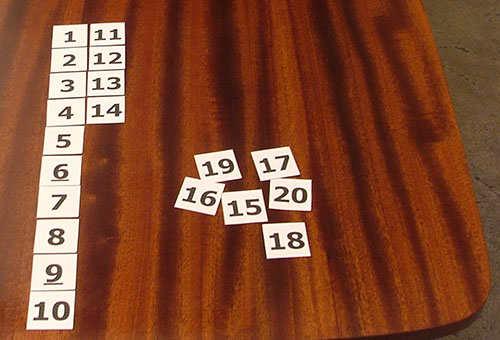
How to teach to count to 20?
The next stage in the mathematical education of the child at home will be counting up to 20. You should start classes only when the baby has already mastered the numbers from 1 to 9 and the number 10 well.
- Explain that each subsequent (further 10) number will consist of two digits. In other words, each number is divided into tens and ones. The first digit is tens, the second is units.
- Use two boxes. Put ten objects in one (balls, cubes, etc.) in the other - one (2, 3, 4), this good example will help the baby understand what's what.
- Say that all the numbers in the units position go one after the other, that is, after 11 comes 12, then 13, 14, etc.
- When the child understands the essence of counting to 20, you can give him a small task. For example, ask your child to put 16 dryers (sweets, balls) in an empty box. In this case, the child must count aloud.
![]()
How to teach to count to 100?
By the age of 4-5, when the baby is already counting from 1 to 20, you can introduce him to numbers up to 100. This requires some patience and time, learning to count is a rather long and laborious process.
- First of all, tell me that there are 9 tens in the number series up to 100. Name the numbers - 10, 20, 30, 40, 50, 60, 70, 80, 90. But make a reservation that there are still units between these numbers, that is, these the numbers don't go one after the other.
- After this short overview lesson, invite your child to learn 10 new numbers per day. Start with the third ten (21, 22, 23…). Before going to bed, ask your child to tell you what he has learned. At the same time, you can repeat the material covered by counting any items.
- When the child has learned several dozen numbers, play a game with him: show a number series with a missing number in the middle. The kid must find and insert the lost element.
- Praise your child for correct answers, rejoice in his success. Motivate your child to learn.
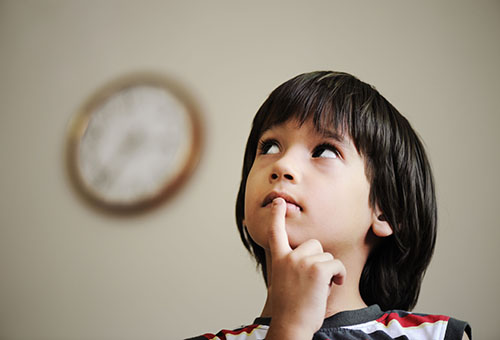
How to teach adding and subtracting?
Basic operations such as addition and subtraction will be useful to the child even before school. The ability to count objects in everyday life will give the crumbs self-confidence, and also give impetus to the development of intelligence. But where to start?
First of all, remember - no math lessons! Just a game and an interesting pastime.
- Prepare visual material: apples, sweets, cubes - something that the baby will be interested in operating with.
- First, parse a prime number (for example, 3). You can get a total of 3 by adding two candies and one. Ask the child to show how much he understood the explanation.
- Keep adding until the child understands what's what, and only then proceed to subtract.
Experts say: children should be taught to count from a kindergarten age. Moreover, the younger preschooler, with the proper organization of such an activity, will like it. But here parents may face another problem. Teaching your toddler how to add and subtract on paper can be easy. But how to teach a child to count in the mind is a more difficult task. There are a number of nuances that will allow you to solve it faster and easier.
Where does the count start?
It is worth starting classes with early childhood. So, for example, the basics of counting can be laid with a baby when he is 3-4 years old. To begin with, parents need to teach the child to find both one and several objects at once. These can be favorite toys, food, etc. Then you should teach the child the concepts of "more", "less", "equally". After that, you can proceed to learning the ratio of numbers and objects. So, you will prepare the baby for the account, and it will be easier for him to master such a science as mathematics.
To teach a child to count to himself, you first need to develop active pronunciation in him (when he aloud, individually counts how many objects he sees in front of him), then he must do it in a whisper, and then completely to himself, giving out only final result. Psychologists assure: in this case, the main thing is to interest the baby, then it will not be boring for him to master the account.
With a baby, you can learn to count on the street. So, for example, you can count the number of cars passing by. Make it harder and group them by color. For example, 3 blacks, 5 grays, 1 red passed. You can also count the birds on the sidewalk, people at bus stops. The numbers in the numbers of cars and everything that catches your eye. This will make it much easier for the child to absorb the information. After all, everything is also duplicated by visual memory.
Teaching counting to a preschooler

The easiest way is to prepare special assistants, for example, chips. It can be at your discretion counting sticks, matches, checkers and other identical figures. The key concept is the same in this situation, because the baby should not be distracted. As a rule, it is easier for a preschooler to learn counting up to 5. After he learns it, you can move on to solving the problem: how to teach a child to count to 10.
To get started, sort out the composition of the number with the baby. Better to explain concrete examples. If he has three sweets and gives one to his mom as a treat, how many will be left? Two. This means that if you subtract 1 from 3, you get 2.
Then it is necessary for the child to decompose all the pairs that are obtained with the numbers 1 and 2, and also to change places so that there is an understanding that the result will not change from changing the places of the terms. Again, try the example with removing one candy from the total mass. Your task is to consolidate the result. Then try to go from the opposite and treat the child who has 2 candies to another one. How much will the result be? This is how you work out the addition.
Do not ignore the concept of zero. This is extremely important for the full learning of the account. Moreover, it is not so difficult to explain the complete absence of something. It is enough to lay out a few items on the table, count them, and then completely remove everything.
You need to try to make all these actions automatic for the child. Therefore, as you continue your studies, regularly return to such previously completed examples. Gradually, understanding step by step, you will be able to solve such a problem: how to effectively teach a child to count to 20, and 30, and 100.
We teach to count a schoolboy
It will be more difficult for the child if he did not have time to learn to count before school. After all, there are already examples. And how to teach a child to quickly and correctly count examples when he cannot cope with the solution of simple actions in his mind.
 Again, you need to start small. Only it’s not like learning to count up to 5, as in the case of kids, but to solve the dilemma: how to teach a child to count up to 10. This way things will go faster, plus an older child already operates better in tens.
Again, you need to start small. Only it’s not like learning to count up to 5, as in the case of kids, but to solve the dilemma: how to teach a child to count up to 10. This way things will go faster, plus an older child already operates better in tens.
To teach a student to count, you will need 2 regular rulers with divisions up to 10 and 20 cm. different sides necessary steps and visually see the result. So, for example, invite the child to solve the example 3 + 3. Let him find the first number on the ruler, and then step by step to the right with his finger (we are talking about addition). There are three steps to take. What number did you get? Correct - 6. In the same way, the child learns to subtract.
After he “counted” with his finger on the ruler, it is necessary to repeat the example orally. It can take about a week, in some cases two, to train and consolidate the results. And closer to the second half of the training period, try to minimize experiments with the ruler, increasing the calculations in your mind.
How to count round numbers
Despite the fact that round numbers are quite simple in terms of visual assessment, kids have a lot of problems with them when counting. Alternatively, you can use the ruler again. Just explain to the child that when adding or subtracting numbers ending in zero, you need to work with the first digits, zero remains unchanged.
Multiplication and division
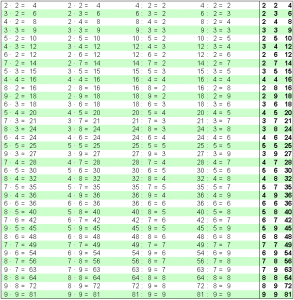
Of particular difficulty in children can be the solution in the mind of such examples as multiplication and division. As a rule, a detailed explanation of what is what helps. On the simple examples, for example, 3x3, you can explain what it means three times three, i.e. you need to add three triples and get 9 as a result. To begin with, of course, such explanations should be carried out on paper for greater clarity. Next, you need to memorize the multiplication table. If the child understands the principle quickly, then it will be easy for him to teach it.
Division is more difficult. Therefore, experts recommend starting with learning to divide by 2. After all, it is much easier to divide everything equally. Immediately, you will have to explain to the child what is the difference between such types of numbers as even and odd. Move on to more difficult division exercises only after you are sure that the baby has learned everything well. Otherwise, he will simply get confused.
To teach a child to count correctly and correctly, try to listen to the advice of psychologists and put them into practice. First of all, do not tune in to a quick result. It just seems to be easy to count. And if you think about how many thought processes a baby needs to do, everything will turn out to be not so unambiguous.
In the course of your classes, be sure to monitor the reaction of the child. If he suddenly gets bored, either offer him another option, or even change activities for a while. If you insist on classes, the child will develop the wrong connection: forcibly means bad. And to achieve results in this situation will not be easy.
Do not heroically engage if you are unwell or nervous. With this, nothing will come of it, the material will not be learned. It is better to postpone them until later, when the situation settles down.
In the process of teaching a child to count, do not be nervous, use tactile sensations- let him shift the items for counting from place to place, so it's easier for him to remember. Be sure to review what you have already learned regularly. At the beginning of the lesson, do not be lazy and take at least 5 minutes of what you have already studied. At the same time, do not stop there.
Be sure to praise the baby for every success. But you should not scold - you are not a teacher at school and do not fight for grades. If the child cannot understand, help.
How to teach a child to count quickly? It happens and is quite easy. It is enough to approach this issue with all love, patience and perseverance. Naturally, such activities should be only for pleasure and joy. No one will be forced to study. Try to come up with a motivation system that suits you and your child, and then things will work out.
When entering the first grade, they usually do not check the child's ability to count. But in fact, already in the first lessons, children are faced with the need to apply mathematical skills. Helping a child master the basics of counting before school is the task of parents.
Why teach children to count before school
Of all the creatures living on Earth, only people can count - this is one of higher functions brain. Mathematics is necessary for each of us in everyday life: to count money, to correlate the number of guests and forks and spoons, etc. Even preschoolers are often faced with the need to apply arithmetic skills: check whether the seller gave the change in the store correctly, rearrange the chip in the walking game. That is, a complex, but very interesting science there is practical use.
Another reason for early acquaintance with the account - development of the little man. At the age of 2-3 years, the baby is already able to learn mathematical concepts. More than younger child the easier and faster the learning process. Of course, we are talking here exclusively about the game form - classes should not resemble boring lessons. It has been proven that learning to count (especially oral) improves memory, attention, logical thinking, develops intelligence and ingenuity. Children who know how to operate with numbers in their minds quickly figure everything out. At school, they do well not only in arithmetic, but also in other subjects. Not in vain mathematics is called the queen of sciences - according to its laws everything happens in this world.
 Mathematics is the science of all sciences.
Mathematics is the science of all sciences. Start
Start learning to count possible from two years(sometimes even a little earlier). Dressing the baby, we count his body parts: it turns out that the crumbs have two arms, the same number of legs, eyes and ears, but there is only one nose. The head is also one, so you need one hat, but for two hands you need two mittens. A little later it turns out that there are five fingers on the hands and feet. After some time, start periodically asking the child questions - how many eyes (nose, hands, paws, tails) does the doll (bears, bunnies, etc.) have? You can count anything with your child- steps, flowers in the picture in the book, buttons, pieces of food in a plate, pebbles, birds, etc. And you need to do this always and everywhere: on a walk, in the process of washing dishes, setting the table, dressing, bathing, playing. And rhymes, counting rhymes and jokes will help to remember the sequence of the number series. Only a child should not thoughtlessly memorize and say: one-two-three-four ... The kid should know that "three" is not just a word, it's three of any subject. And be sure to read the fairy tale “The Kid Who Could Count to 10” to your child.
 The kid who counted everyone.
The kid who counted everyone. Introduction to numbers
If a two-year-old is not yet capable of abstract thinking, then kids of 3-4 years old are already quite ready to get acquainted with numbers - signs indicating quantity. To do this, you need cards with their images or figures made of cardboard, wood, plastic, etc.
We take 3 cubes (cars, dolls, sticks) and put the number 3 next to it. We take 5 toys - put the number 5 next to it, clearly pronouncing each action. Then it's the turn of the young apprentice. Now the parent only lays out a certain number of items, and the child independently finds a card with the desired number.
 It is also possible to mold numbers from plasticine.
It is also possible to mold numbers from plasticine. By the way, a baby from about 4 years old can already be “trained” in reverse. To prevent the lesson from being boring, play up the actions: for example, count down the seconds left until the rocket launches. This important skill prepares the child for the next stage - the development of subtraction. Well, and, of course, attention and memory develop in the learning process.
A few words about methods
There are author's methods for teaching counting skills to preschoolers - the programs of Nikitin and Zaitsev, Montessori and Doman and many others famous people who have devoted their lives to the study early development. You can, of course, focus on one thing. But, as practice shows, each technique has not only advantages, but also disadvantages.
For example, a popular method of teaching Doman's account involves showing the child cards with large bright dots (diameter - 2 cm). To begin with, cards are used on which the number of points does not exceed 5. Later, the number of objects reaches 20, then - up to 100. The adult simply demonstrates the material to the young mathematician and clearly tells him the number. Soon the child is already unmistakably, without even counting the points, he easily answers the question "How much?" At the same time, it will not be difficult for him to distinguish between cards with 19 and 20 circles. The kid very quickly learns to visually perceive the amount. We adults, who were not given the opportunity of such training in childhood, can hardly imagine what it is like. Then comes the turn of showing the baby a combination of sheets: for example, material with 10 and 2 points is taken, the action is pronounced: “10 plus 2 is equal to 12”.
 Doman cards.
Doman cards. Judging by the reviews, Children learn to count very quickly. They easily mentally cope with the addition of two-digit numbers. But the technique does not affect other important mathematical concepts - wider-narrower, higher-lower, longer-shorter, etc. It simply teaches to count automatically - neither logic nor intelligence develops. The child becomes like a “walking calculator”, which cannot independently figure out how to use its skills in practice, but willingly answers questions from adults. The situation is the same with other methods - Montessori programs do not pay attention to the development of the right hemisphere at all, the Zaitsev method quickly teaches counting, but does not contribute to the improvement of the necessary for writing fine motor skills, in the Nikitin system, creativity and the development of speech are bypassed. Therefore, there is another option - the selective use of visual material, ideas, rules and games of several programs.
Each child is individual, and only parents know the developmental features and interests of their child. Using publicly available information, any an adult is quite capable of compiling a unique “program” for teaching mathematics for his own baby.
We operate with numbers
A child who has learned to count at least within five begins to acquaint a child with addition-subtraction. Here, of course, one cannot do without visual material - objects that are the same and differ in some respects. Ready-made kits are easy to find in the store, but also making your own is not that hard.
 One plus three equals four.
One plus three equals four. An elementary way: cut out pictures from books and magazines and stick them on thick cardboard. However, in the household of every kid today there are toys that can serve as counting material - cubes, pyramid rings, sticks, figures from kinder surprises, small cars, etc.
 Pencils are fine too. This is number three.
Pencils are fine too. This is number three. Take, for example, a cube and say: "One". Then we put another cube to it and say: Plus one equals two. Show your child examples of subtraction in the same way. Do not be afraid to operate with the concepts of "+", "-", "=". You can explain their meaning to the baby, but this is not necessary: it is enough to provide the children with facts, and born researchers themselves will very quickly deduce a pattern. Also, do not forget about the concepts of "more-less" and their designations ">" and "<». Освоить новый материал помогут игрушки. Например, накройте стол для 5-ти гостей - плюшевых зверей. Расставьте 4 тарелки и обратите внимание крохи на то, что одному гостю блюда не хватило. Это значит, что посуды меньше, а зверей больше. Добавляем одну тарелку - и вот уже предметов стало поровну. Другой простой наглядный вариант - нарисовать на большом листе бумаги цветок с 6-ю лепестками и вырезать из картона такое же количество бабочек. Сначала вручаем малышу, например, 4 бабочки и просим рассадить их на лепестки. Ребёнок видит, что два из них осталось незанятыми. Проговариваем: "4 is less than 6" and then add: "For two."
Learning by playing
Preschoolers learn only through play. Children learn well only what they are really interested in. And the authors of early development methods understand this very well.
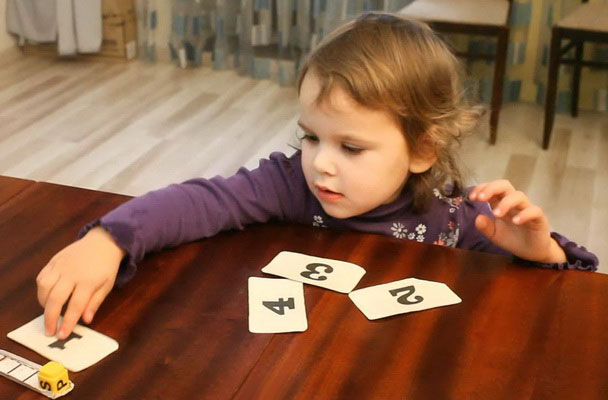 Training under the program Sergey Polyakova.
Training under the program Sergey Polyakova. For example, in the program of Sergey Polyakov there is a game that allows kids to quickly master mental counting and comprehend the composition of the number. 5 cubes are laid out in a row in front of the child (it is recommended to start with a smaller amount). Then the adult takes 2 cubes in his hand and hides it behind his back. There are three objects left in front of the baby, and he must answer the question: "How many cubes are hidden in the hand?" At the same time, the author of the methodology warns against counting objects with fingers (namely, this is how adults usually teach children) - everything should happen in the mind, visually. The crumbs very quickly remember what 5 cubes look like, and how 3. And now a few more games that can interest the child in counting:
- Score- all kids will join the process with pleasure, preparation is required from parents - making money cards with numbers.
- Clap- cards with numbers “shirts” up are laid out in front of the child; the kid opens the card, sees the sign and must clap his hands so many times.
- Numeric Neighbors- often ask the child to name a number that lives, for example, between 5 and 7, 4 and 6, etc.
- Walking games- those where you first throw a bone, and then make the required number of moves; for very young children, a similar game can be made independently by gluing a cube, where the number of points on the faces does not exceed 3.
- children's domino- not simple, with dots or pictures, but special: on some halves of the chips - numbers, on the other - images of fruits, vegetables and other items; with the help of this manual, children learn to correlate the number of things with signs.
- Help in the kitchen:“How many people will be having lunch? Let's count: mom, dad, Katya and you. How many plates do you need? Get the right amount of spoons and forks!”
- Laying out the coins: Invite your child to sort the coins according to their value.
- Arrange in order: Ask your child to arrange the number cards in increasing order.
- Missing cards: an adult lays out a series of cards with numbers, intentionally skipping some elements of the number series; The child is asked to fill in the gaps.
- Extra items: cut out pictures from books and magazines with images of the same subject, add a few cutouts that are not related to the topic, and invite the child to find extra items and count them.
- Reading fairy tales- after reading the next fairy tale together, ask the child to remember and count the number of positive (negative) characters, the number of friends (enemies) of the main character.
There are many ways to get interested in mathematics and teach counting. Ideas surround us everywhere - you just have to take a closer look.
It seems that there is nothing complicated in counting, but small children refuse to understand why after 9 comes 10, and after 30 - 31, with such questions they sometimes drive adults to despair. But in order for the baby to learn to count, it must be taught this. To do this, there are many techniques and methodological techniques.
How to teach a child to count quickly?
The memory of young children is selective, they learn only what interests them or causes any emotions. It is unlikely that kids will remember things that are not interesting for them, even if their parents insist on it. Therefore, the task of adults is to interest children so that they themselves want to learn how to count. Then the child himself will not notice how quickly he will learn to count.
Specialists in the field of linguistics have long noticed that when learning languages, the human brain most easily masters numerals. When learning the alphabet and writing, some effort is required, but for learning to count, you do not need to sit over books for a long time. And the account can be dealt with everywhere: in transport, at home, on a walk.
How to teach a child to count to 10 correctly?
- If your kid is 2 years old, then it's time to teach him how to count. First you need to teach him to count from 1 to 5. While on a walk, you can count cars, houses, windows, birds, absolutely everything is subject to count. When dressing a child, you should pay attention to the fact that there are always 2 socks, but tights - 1. Upon returning from a walk, you can count the shoes in the hallway and even ask the baby a task: how many people can wear as many shoes as he sees.
- When reading books, you do not need to skip the pictures, let the child calculate the number of animals and objects shown in the illustration. Counting verses are also good in this matter. Also, the baby should be explained that by learning to count, he gains benefit for himself. After all, he can equally divide the sweets. When setting the table, you can ask the baby for help: let him give you a certain number of spoons or plates.
- Before going to the store, you can say out loud - how much and what you need to buy. In this case, you need to bend your fingers, and then ask the child to repeat the list. In the process of shopping, you need to ask the child to tell you what else is left to buy. Upon arrival from the store, the products can be counted, if something is missing, then the baby will understand that his mother cannot do without his help, concentrate and train his skills. If the child remembers all the products, he should definitely be knocked down. Next time, the task can be a little more difficult.
- Playing in the store will also help reinforce numeracy skills, but it will be easier with children to play without money. Babies of 3 years of age will be interested in the payment process, and candies, buttons or pieces of paper can act as a currency. At the right expense, the child must be encouraged.
- If the baby has already learned to count, then you can start learning numbers. Children often easily memorize numbers from 1 to 10. The main thing is that he understands that a certain number means the number of certain items. For example, 5 apples, 5 candies or 5 balls will always be denoted by the same number. Children are very fond of magnetic numbers and Velcro, attached to the refrigerator, board or other surface. The main thing is that the baby always sees these numbers and then he will quickly remember them.
- When the child learns the numbers, you can introduce the concept of 0. To do this, you can count those items that are not there. For example: 0 cars, 0 sweets. So 0 means something that doesn't exist.
- Older children - at the age of 4-5 years old, can already be explained - how numbers are formed. For example, lay out 10 counting sticks in a row. In ancient Russia, 10 was abbreviated as "twenty". 1 stick should be placed on top, it's good if it differs in color. So it turns out that 1 on twenty - it turns out 11. You can add sticks to the top row, thereby reaching 20. The only exceptions are the numbers 40, which in ancient times meant "a lot" and 90, meaning "nine to a hundred."
How to teach a child to count to 100?
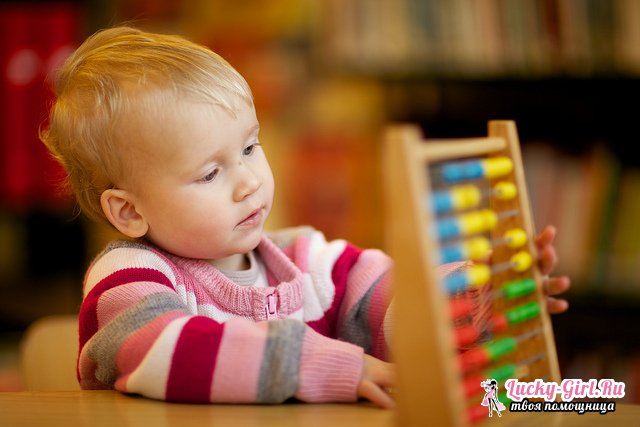
When teaching a child to count from 1 to 100, you do not need to demand quick memorization from him. Let everything go in stages, for example, increase the numbers by a dozen once a week. And before starting a new lesson, you need to ask him to repeat the material already covered. Moreover, a new one can be learned only when the child has memorized what has already been learned. Moreover, the child must not only memorize the score, but also understand it. The science of mathematics is based on the search for understanding, the baby must figure out why the numbers are arranged in this way and not otherwise.
As a consolidation of the material, the baby can be asked to solve some problems, such as: find the missing number; name the number and ask - what is in front of it; name the numbers in between.
If the child has mastered the count from 1 to 100, then you can begin to learn the reverse count. It is better to show it on the fingers, bending them or on counting sticks. It is easiest to start with 5. The child's thinking plays an important role here. It happens that the baby easily copes with mathematical calculations, but the countdown causes difficulties for him. At the same time, you can’t put pressure on the child - he must learn the countdown using examples, for example, using the buttons in the elevator.
Today, first-graders can use a calculator and a computer, but it is more difficult for them to count in their minds, because the brain, like muscles, needs constant training. It is the mental counting, learned in childhood, that helps the development of the child's mental abilities.
Many parents think that children, especially those under the age of 5, cannot yet engage in mental arithmetic, but mathematical abilities do not arise from the outside - they are formed. And if they are not trained, then they may not develop even by the age of 10. Already from the age of 3, a child can be taught the basics of mathematics.
It is also worth explaining to the baby what is - more - less. Even when reading a book, you can pay attention to which animals are larger and which are smaller. When playing with a child in a cube, you should count, and then ask the child to count - which color cubes are more and which ones are fewer? At first, the baby will be confused, it will not be easy for him to remember such concepts, but in the future he will become well versed in this matter.
To explain to a child such a concept as “equal”, you can give him an example: Kolya has 3 apples and Petya has 3 apples - who has more? No one, because they are equally divided! You can offer the baby to divide equally any number of objects so that he better remember this concept.
Today, bookstores offer a wide range of early childhood development manuals, including manuals on how to teach a child to count. But before purchasing, they should be studied. It is necessary to avoid such examples as “determine without counting”, “try to guess how much it will turn out”, because this approach to mathematics is not correct. You cannot teach a child through such examples, because mathematics is an exact science and here you need to count, Anna guess. Answers to the "guess" question will be ambiguous and the child may think that the correct answer can be guessed rather than calculated.
How to teach a child to count: video
Some parents of primary school kids say that their children have a humanitarian mindset, so their crumbs do not have pronounced math abilities. But in order to simply deal with the account, you do not need any special abilities. In addition, mathematical calculations stimulate the development of intelligence and help form a child's logical thinking. The sooner parents begin to train the brain activity of the crumbs using mathematical calculations, the sooner they will see a noticeable result.
